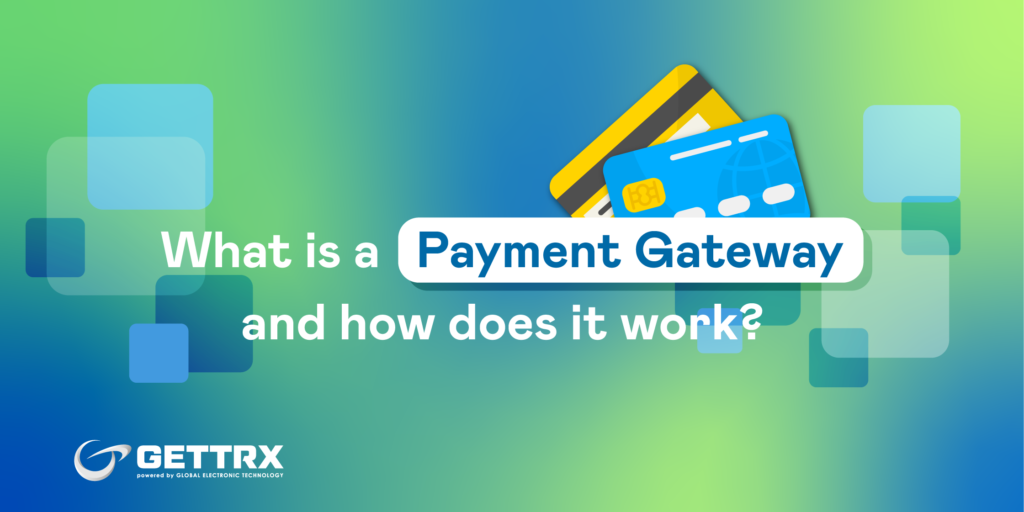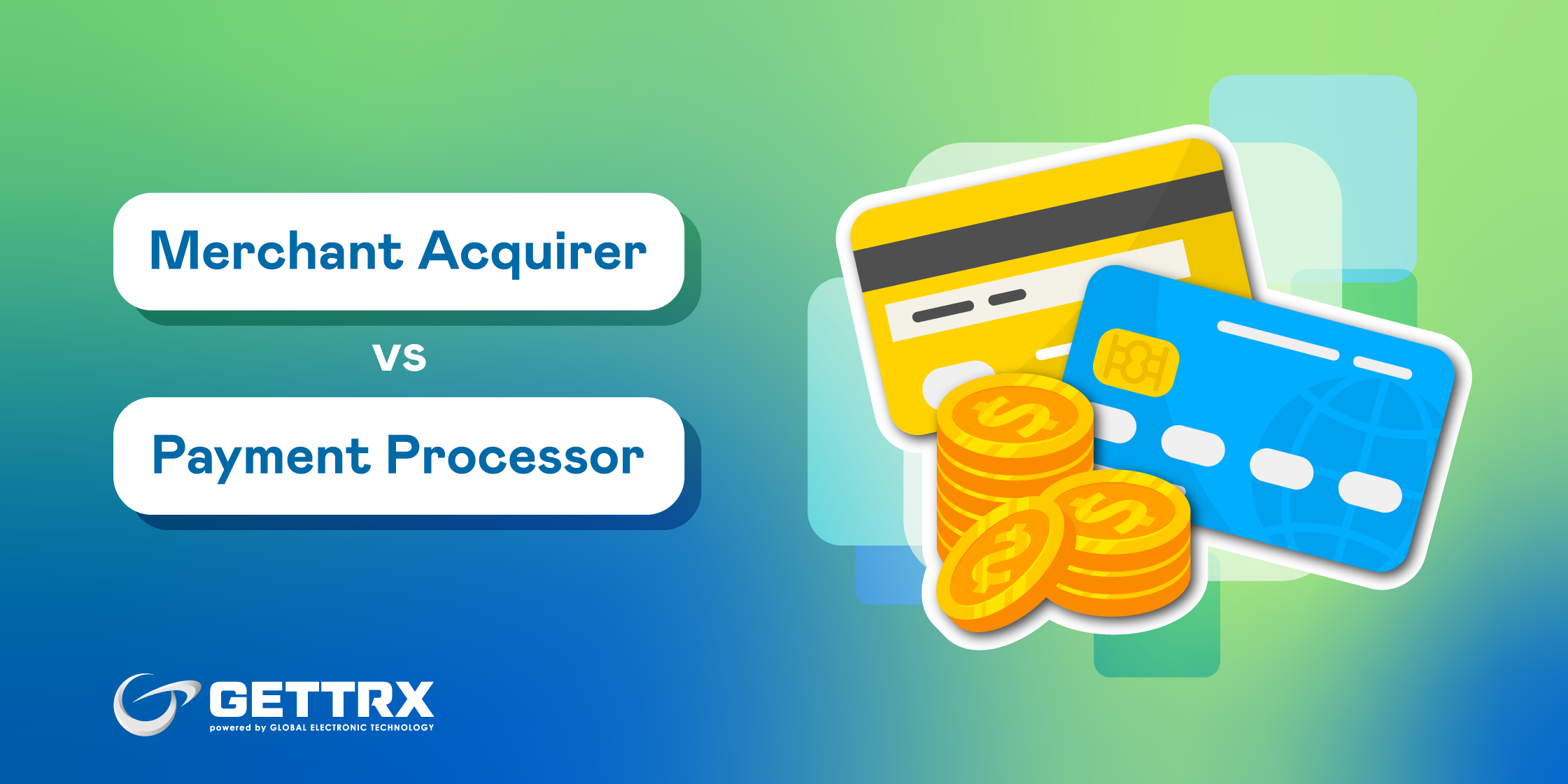Let’s face it—payment processing can be confusing. You have merchant acquirers, issuing banks, payment processors, acquiring processors, and more.
So what is the difference between a merchant acquirer and a payment processor? And how do you create the most efficient and secure processing framework for your business?
In this article, we’ll cover almost everything you need to make an informed decision.
Disclaimer: While building the most sophisticated payment processing and risk management technology, we’ve distilled every form of bias or opinion to ensure we only give you the facts.
Feel free to be part of our journey and see how you can save $10,452 every year in operational costs with GETTRX.
Without further ado, let’s jump right in:
Table of Contents
Key Takeaways
- Merchant acquirers and payment processors are two different entities that provide businesses with the ability to process payments safely and securely.
- Merchant acquirers are responsible for approving businesses to accept credit and debit cards, as well as providing back-end merchant services.
- A payment processor consists of two components- acquiring processor and issuing processor
- Payment processors provide the technology to make payment transactions possible, such as providing a payment gateway.
- Merchant acquirers and payment processors work together to enable businesses to accept payment transactions from customers.
What is a Merchant Acquirer?
A merchant acquirer is a financial institution that helps merchants accept and process customer payments. They are also known as acquiring banks or acquirers.
The acquirer may provide merchants with technical and financial services in a full-service merchant acquiring agreement. These include:
- Credit card processing
- Merchant accounts
- Cardholder data security services
- Fraud prevention and detection services
All these work together to help merchants securely process payments online and in-store.
How Does Merchant Acquiring Work?
The entire process can be divided into five significant steps:
Step 1: Merchant Account Setup
The merchant needs to establish a merchant account with an acquirer. This involves submitting an application, providing business details, and agreeing to the terms and fees associated with the account.
Step 2: Payment Terminal Integration
The acquirer provides the merchant with payment terminals or Point of Sale (POS) systems that enable the acceptance of card payments.
Step 3: Transaction Processing
When a customer makes a purchase using a credit or debit card, the payment terminal sends the transaction details to the acquirer.
Step 4: Transaction Authorization
The acquirer sends the transaction information to the card issuer (the bank that issued the customer’s card) through the card network (e.g., Visa, Mastercard, American Express). The issuer checks the card’s validity and available funds and either approves or declines the transaction.
Step 5: Transaction Settlement
If the transaction is approved, the funds are transferred from the issuer to the acquirer, who then deposits the funds into the merchant’s account minus any fees.
Of course, this is an oversimplification, and many different factors are involved, including interchange fees. But this should give you a basic understanding of how merchant acquiring works.
What is an Issuing Bank?
An issuing bank (also known as a card issuer) is a financial institution that issues credit or debit cards to customers. They also set the terms and conditions for using these cards, like interest rates, fees, etc.
The issuing bank also sets up the customer’s account and takes responsibility for unauthorized card transactions.
What is a Payment Processor?
A payment processor (also known as a payment gateway or payment service provider) is a company that provides merchants with the technology to process payments from customers securely. Payment processors allow merchants to accept credit and debit cards and electronic payments like ACH transfers and e-checks.
Think of payment processing as the various steps involved in the authorization, clearing, and settlement of electronic transactions between the merchant, acquirer, card network, and card issuer.
Payment processors usually provide merchants with the tools to accept payments, such as:
- A payment gateway
- Shopping cart integration
- Fraud prevention tools
- Recurring billing options
- Transaction reporting and analytics
- Payment page customization
- Customer payment summaries
- Dispute resolution services
Let’s break down the two main components to understand the full scope of a payment processor’s services.
An Issuer Processor
An issuer processor is responsible for processing payments from cards issued by Visa, Mastercard, American Express, and other card networks. They work with the acquiring bank to authorize, settle, payments into the merchant’s bank.
An Acquiring Processor
An acquiring processor is responsible for processing customer payments issued on behalf of the merchants. They work with the merchant’s bank to authorize and settle payments.
How Does Payment Processing Work?
Like merchant acquiring, payment processing involves several steps to complete a transaction.
Step 1: Transaction Initiation
When a customer makes purchases with their credit or debit card, the payment details are captured by the merchant’s payment terminal.
Step 2: Transaction Authorization
The payment terminal sends the transaction information to the merchant’s acquirer. The acquirer then forwards the transaction details to the card issuer through the card network.
Step 3: Issuer Response
The card issuer checks the card’s validity and available funds and then either approves or declines the transaction. This response is sent back to the acquirer through the card network.
Step 4: Response Relay
The acquirer relays the issuer’s response to the merchant’s payment terminal. If the transaction is approved, the payment terminal displays an approval message, completing the transaction.
Step 5: Transaction Clearing
At the end of the business day, the merchant sends all approved transactions to the acquirer for settlement. The acquirer processes these transactions and calculates the net amounts owed to the merchant.
Step 6: Transaction Settlement
The card issuer processes the transaction, deducting the appropriate funds from the customer’s account and sending it to the merchant’s acquirer. The acquirer then transfers the net amount to the merchant’s bank account.

What Is a Payment Gateway and How Does It Work?
A payment gateway is an intermediary between the merchant’s website and the acquirer. It securely transmits transaction data from the customer’s device to the payment processing system, allowing for secure and seamless payments.
A payment gateway securely transmits transaction information between a customer, merchant, and the acquiring bank. It also enables online merchants to accept electronic payments, such as credit cards, debit cards, and digital wallets.
Here’s how it works, broken down into steps:
Step 1: Customer places an order
The customer selects the products or services they want to purchase and proceeds to the merchant’s website or app checkout page.
Step 2: Customer enters payment information
The customer inputs their payment details, such as credit card information, on the secure checkout page.
Step 3: Payment gateway encrypts data
The payment gateway encrypts the customer’s payment data to ensure it remains secure as it’s transmitted to the acquiring bank.
Step 4: Transaction authorization
The acquiring bank forwards the transaction details to the customer’s card-issuing bank, which verifies the card’s validity and checks whether the customer has sufficient funds for the purchase.
Step 5: Issuing bank sends a response
The card-issuing bank sends a response code to the payment gateway, indicating whether the transaction is approved or declined.
Step 6: Payment gateway forwards the response
The payment gateway relays the response to the merchant’s website or app, which displays an appropriate message to the customer (e.g., “Payment Successful” or “Payment Declined”).
Step 7: Funds Settlement
If the transaction is approved, the card-issuing bank transfers the funds to the acquiring bank, which then deposits the funds into the merchant’s account. This process typically takes a few business days.
Step 8: Payment confirmation and order fulfillment
Once the merchant receives the funds, they can fulfill the customer’s order and send a confirmation email or notification.
Merchant acquirer vs payment processor: similarities
Merchant acquirers and payment processors are critical elements of the payment processing landscape. They are integral in facilitating electronic transactions between merchants and customers, ensuring the transaction process is smooth, secure, and efficient. Here are some of their similarities;
1. Collaboration for transaction processing
Merchant acquirers and payment processors work closely together in the transaction process.
The merchant acquirer contracts the payment processor to handle the technical aspects of transaction processing, while the acquirer focuses on risk management and maintaining a direct relationship with the merchant. Their collaboration ensures that transactions are authorized, processed, and settled correctly.
2. Compliance with industry standards and regulations
Merchant acquirers and payment processors must adhere to industry standards and regulations to ensure the security and integrity of the electronic payment system.
Additionally, they are subject to card network rules and regulations, such as those set forth by Visa, Mastercard, American Express, and Discover, to ensure consistency and reliability across the payment ecosystem.
3. The shared goal of seamless customer experience
Both focus on minimizing transaction times, ensuring payment processing security, and providing easy-to-use payment solutions to foster customer satisfaction and encourage using electronic payment methods.
4. Ongoing innovation and technology adoption
As the electronic payment industry evolves, merchant acquirers and payment processors continually adopt new technologies and innovative solutions to improve transaction efficiency, security, and overall customer experience.
They work together to implement emerging payment methods, such as contactless payments, mobile wallets, and digital currencies, ensuring that merchants can offer their customers the latest and most convenient payment options.
Merchant acquirer vs payment processor: differences
Merchant acquirers and payment processors are both involved in the process of facilitating electronic payments. However, they each have different roles and responsibilities in the payment processing ecosystem which includes;
| Merchant Acquirer | Payment Processor |
| Partner with merchants to process card payment | Specialize in managing the technical aspects of payment pr |
| Provide hardware and software to accept card payments | Transmit transaction data between the merchant, customer, and various banks involved |
| Manage settlement process, transferring funds from customer’s bank to merchant’s account | Use advanced technology for secure transmission of data |
| Manage risk and fraud prevention | Encrypt, tokenize, and use multi-factor authentication for data security |
| Verify transaction information accuracy | Verify identity of the parties involved |
| Verify customer has sufficient funds or credit available | Route the transaction to the appropriate financial institutions |
| Act as a middleman between the merchant and customer’s bank | Focus on the technical aspects of payment processing |
How GETTRX Can Help
GETTRX is an ideal payment platform for both merchant acquirers and payment processors, offering secure and affordable solutions to facilitate payments.
At GETTRX, we understand that trust and security are major concerns when it comes to payment processing. That’s why we offer an industry-leading system with superior encryption technology that ensures a safe experience for all of our customers.
What’s more, our affordable fees make sure that everyone benefits from our service. Don’t take risks with your payments; contact us now!
Conclusion
Merchant acquirers and payment processors play a key role in the electronic payments ecosystem by ensuring secure and efficient transactions. While their roles may overlap in some areas, they have distinct responsibilities that are vital to the success of any payment transaction.
Now let’s get started with GETTRX! Sign up now and start making payments quickly.







